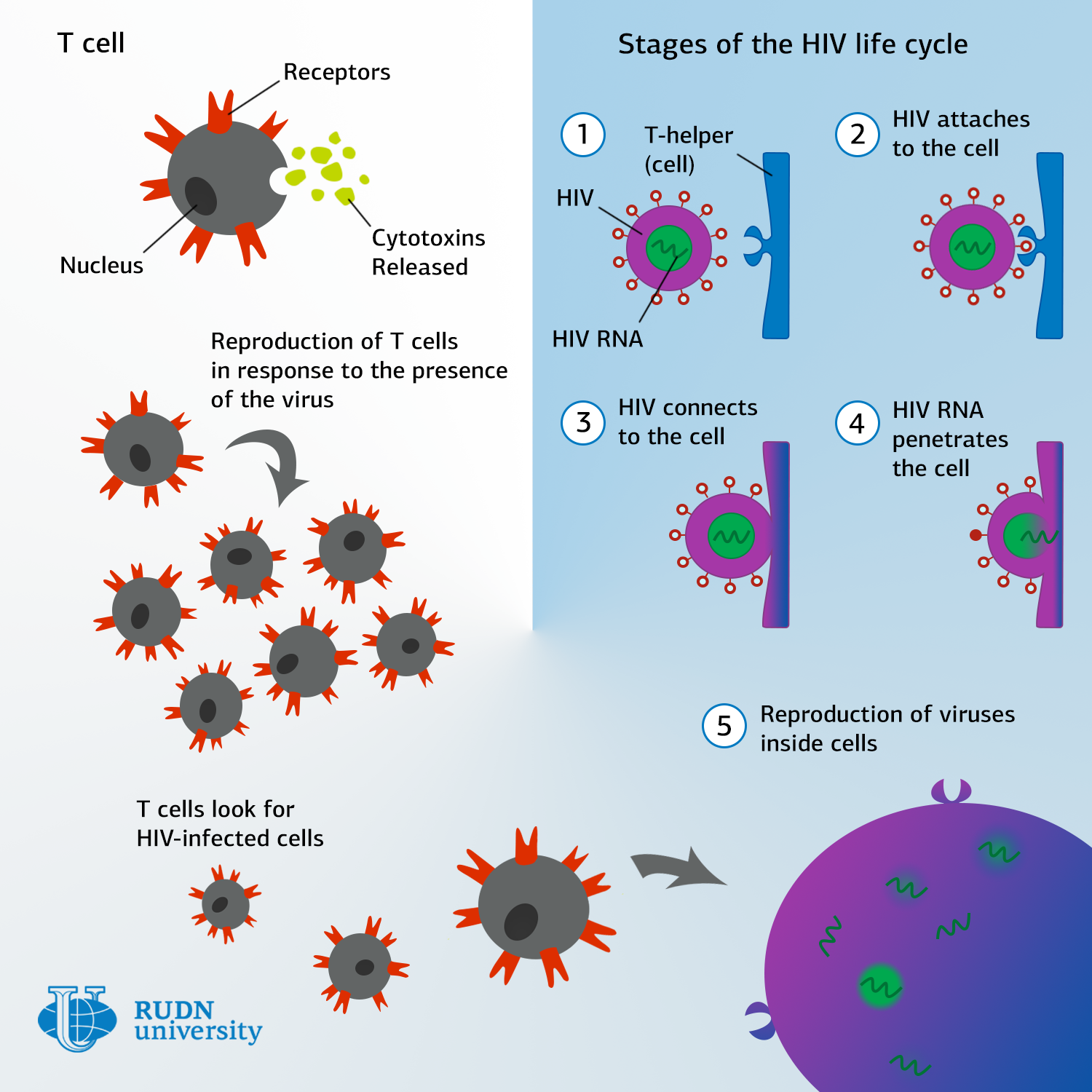RUDN University mathematicians developed a model of the movement of immune cells

Antibodies to HIV infection appear in the body about a month after it has been infected. Prior to that, the immunodeficiency virus can freely circulate and multiply in the body. The vaccine should trigger immune responses at an early stage, when the virus can still be destroyed, or its reproduction effectively restrained. To effectively fight viruses, T-lymphocytes need to find infected cells within 18 hours after the latter entered the body, that is, before the moment when the viral particles begin to be released from the infected cells and spread. To create a vaccine, it is necessary to learn how T-lymphocytes move and how they find virus-infected cells. Vitalii Volpert, head of the RUDN University Interdisciplinary center for Mathematical modelling in Biomedicine, and his colleagues created a computer model of the movement of immune cells to find that out. Researchers from the G.I. Marchuk Institute of Numerical Mathematics RAS, Moscow Institute of Physics and Technology, Institute for Problems in Mechanical Engineering RAS, Uppsala University (Sweden), and Pompeu Fabra University (Spain).
Immunologists know that T-lymphocytes move in the intercellular space not randomly, but in search of target cells, that is, cancer cells or cells infected with a virus. To understand how they do it, RUDN University mathematicians created a computer model of the movement of T-lymphocytes.
Usually, conditions under which cells exist in the body and laws of physics which govern them are considered for modelling cellular processes. The mathematicians from RUDN University also used real experimental data on the mobility of T cells in their model, among other things. In addition, the model considers the interaction of T cells with other cells of the immune system: DC dendritic cells that activate the immune response, CD4 helper cells, and CD8 effector cells that destroy infected cells. To study how to increase the efficiency of the immune response, the RUDN University mathematicians kept changing the parameters of the model by adjusting the “frequency” of different types of immune cells, that is, the proportion of each type in the population, for example, the proportion of cytotoxic T-lymphocytes that “specialise” in searching for cells infected with HIV.
The mathematical modelling showed that 5% frequency of HIV antigen-specific cytotoxic T cells is sufficient to detect infected cells within 18 hours, that is, before the immunodeficiency virus particles are released from the infected cells. If the share of cytotoxic T-lymphocytes is increased from 0.04% to 5%, the model shows that the likelihood of detecting HIV-infected cells within 24 hours also increases by roughly 5 times, from 7-34% to 84-100%.
The results will facilitate, in particular, creation of vaccines against HIV, drugs for autoimmune diseases as well as other disorders associated with immune system dysfunctions. The model created by the RUDN University mathematicians helps to predict the effectiveness of the immune response, determines what characteristics of the behaviour of immune cells help them to stop the development of the disease, and determines the conditions under which the body can fight the infection before the virus begins to multiply intensively.
The study was published in Frontiers in Immunology
Matilda Pavlovna Mityaeva was born in 1925. In November 1942, she volunteered for frontline duty. She participated in the Great Patriotic War from November 1942 to June 1945 as part of the 53rd Infantry Division of the 475th Infantry Regiment. She was wounded twice.
The team led by Sergey Zyryanov, Head of the Department of General and Clinical Pharmacology, became the winner of the All-Russian competition of scientific projects "Technologies for Human Health".
RUDN University constantly adapts to the changes of the modern world and responds to challenges flexibly. This allows us to keep the standard of a world-class research university. The sphere of science is no exception. Peter Dokukin, Head of the Research Division, presented the updated R&D Programme at the meeting of the RUDN University Academic Council.
Matilda Pavlovna Mityaeva was born in 1925. In November 1942, she volunteered for frontline duty. She participated in the Great Patriotic War from November 1942 to June 1945 as part of the 53rd Infantry Division of the 475th Infantry Regiment. She was wounded twice.
The team led by Sergey Zyryanov, Head of the Department of General and Clinical Pharmacology, became the winner of the All-Russian competition of scientific projects "Technologies for Human Health".
RUDN University constantly adapts to the changes of the modern world and responds to challenges flexibly. This allows us to keep the standard of a world-class research university. The sphere of science is no exception. Peter Dokukin, Head of the Research Division, presented the updated R&D Programme at the meeting of the RUDN University Academic Council.